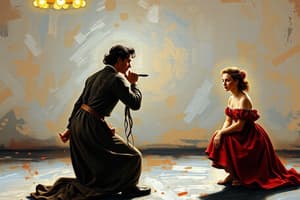Podcast
Questions and Answers
What is the classic text that contains the performance of deities involving the sun goddess Amaterasu?
What is the classic text that contains the performance of deities involving the sun goddess Amaterasu?
- The Tale of the Heike
- The Pillow Book
- The Tale of Genji
- The Records of Ancient Matters (correct)
Who is the goddess that overturned a bucket and exposed her breasts during the performance in the classic text Kojiki?
Who is the goddess that overturned a bucket and exposed her breasts during the performance in the classic text Kojiki?
- Izanami
- Amaterasu
- Suseri-bime
- Ame-no-uzume (correct)
What did Ame-no-uzume do to attract the attention of Amaterasu in the classic text Kojiki?
What did Ame-no-uzume do to attract the attention of Amaterasu in the classic text Kojiki?
- Exposed her breasts and pushed her skirt-band down (correct)
- Sang a sacred chant
- Performed a somersault
- Created a beautiful painting
What action led to Amaterasu peeping behind the rock-cave in the classic text Kojiki?
What action led to Amaterasu peeping behind the rock-cave in the classic text Kojiki?
Which deity pulled Amaterasu out of the cave in the classic text Kojiki?
Which deity pulled Amaterasu out of the cave in the classic text Kojiki?
What event led to the sun coming back to the Earth in the classic text Kojiki?
What event led to the sun coming back to the Earth in the classic text Kojiki?
What is the main theme of gigaku, as described in the passage?
What is the main theme of gigaku, as described in the passage?
What is the significance of Kagura in Japanese history?
What is the significance of Kagura in Japanese history?
What is a unique characteristic of Japanese performances mentioned in the passage?
What is a unique characteristic of Japanese performances mentioned in the passage?
What is the role of the 'shite' in Nō performances?
What is the role of the 'shite' in Nō performances?
Who was responsible for sophisticated the artform of Nō for it to be appreciated by higher-ranking people?
Who was responsible for sophisticated the artform of Nō for it to be appreciated by higher-ranking people?
What did Kagura originally begin as?
What did Kagura originally begin as?
When were female professionals recognized as professionals in Nō performances?
When were female professionals recognized as professionals in Nō performances?
What are the dimensions of Nō theatres since the 16th century?
What are the dimensions of Nō theatres since the 16th century?
What is one of the characteristics of Japanese performances mentioned in the passage?
What is one of the characteristics of Japanese performances mentioned in the passage?
What was gigaku primarily composed of?
What was gigaku primarily composed of?
Flashcards are hidden until you start studying
Study Notes
- The origins of Japanese theatre can be traced back to the classic text Kojiki, which features a striptease performance by the goddess Ame-no-uzume to lure out the sun goddess Amaterasu.
- In 612, the Korean performer Mimashi introduced gigaku, an elegant entertainment, to the imperial court, which consisted of Buddhist processions and dramatic enactments.
- Gagaku, another type of Japanese performance, arrived via China and Korea and was established in 701 with over 200 court-appointed performers.
- Kagura, considered the oldest extant Shinto theatrical dance in Japan, began as a sacred dance performed at the Imperial court by shrine maidens, who were believed to be descendants of Ame-no-Uzume.
- Performances in Japan have historically taken place in various locations such as Buddhist temples and Shinto shrines, riverbanks, entrances of highways, and otabisho (a resting place for deities).
- Nō performance was established around 600 years ago in the 14th century, with the protagonists called the 'shite' and side roles called 'waki'. Female professionals were recognized as professionals in the late 1920s and now represent 10-15% of the professional ranks. Musicians, called hayashi, include a flute, hip-drum, second drum, and stick-drum.
- Nō theatres have had the same dimensions since the 16th century, which were sophisticated for appreciation by higher-ranking people like samurai warriors by Zeami Motokiyo. To play the shite, one must be a man born into the blood lineage of five nō families. Masked actors can bare their faces.
Studying That Suits You
Use AI to generate personalized quizzes and flashcards to suit your learning preferences.




